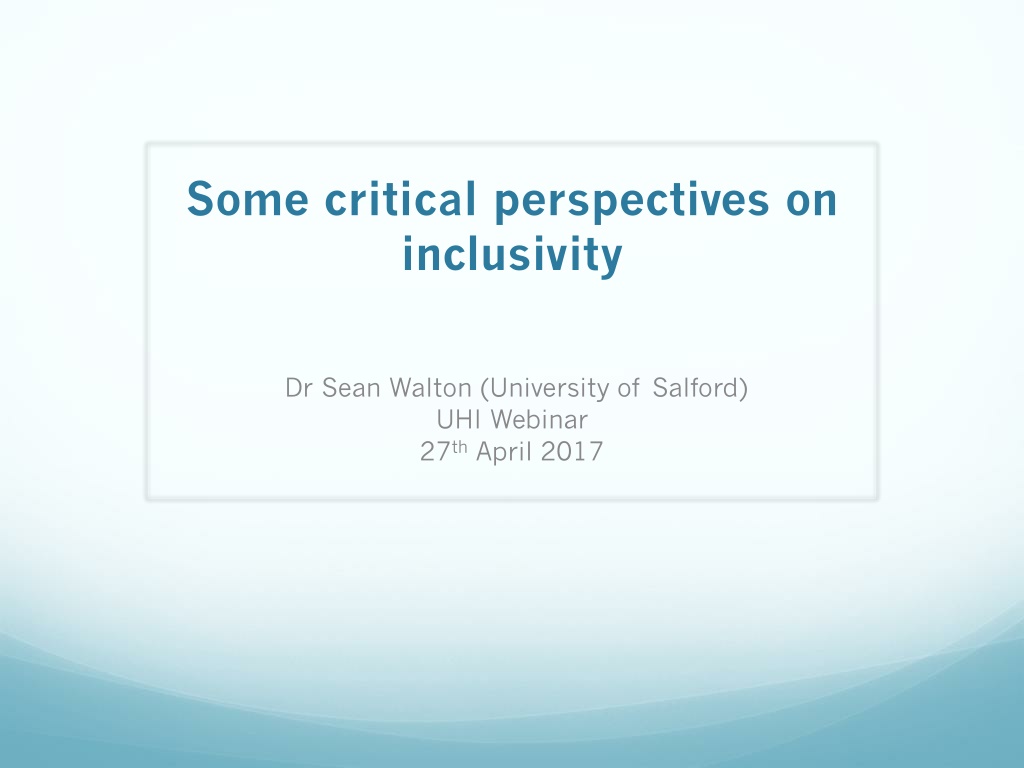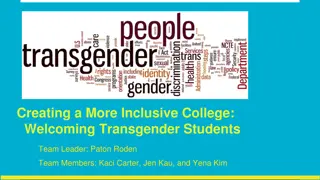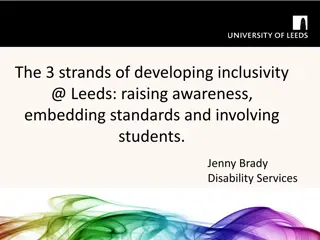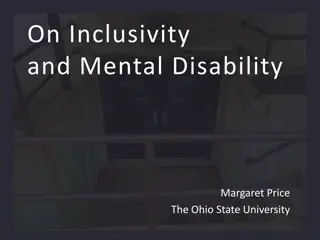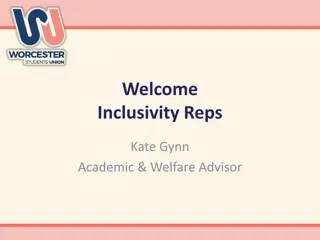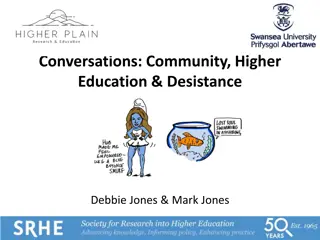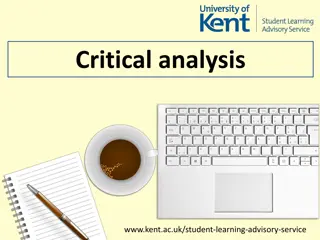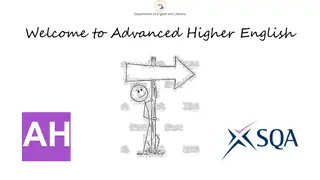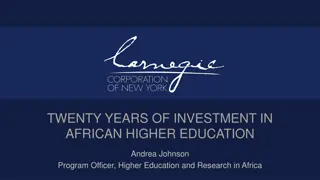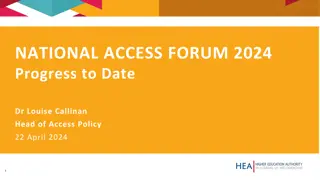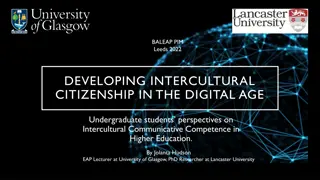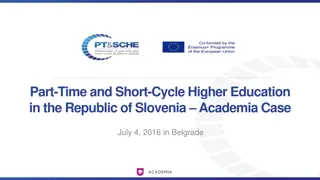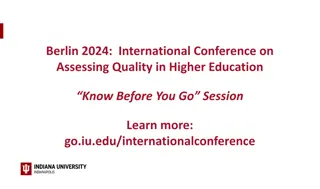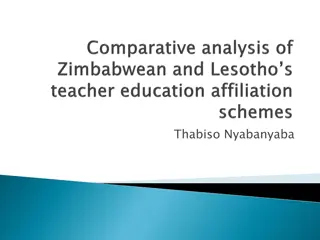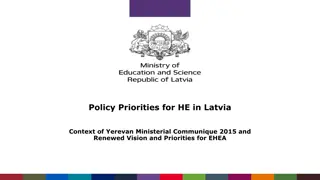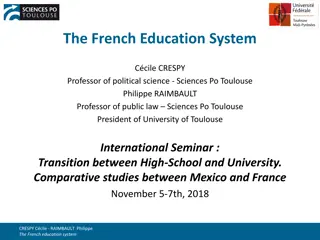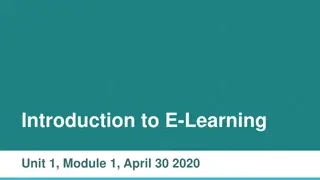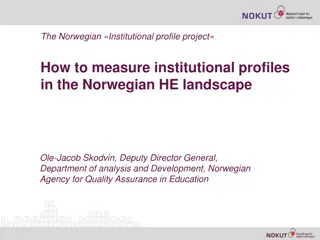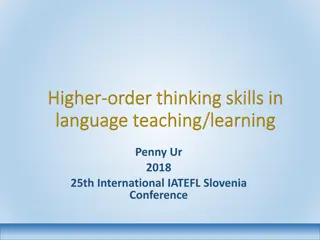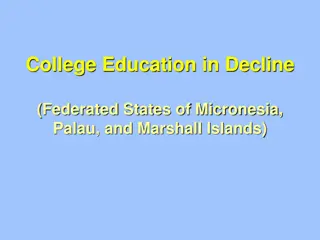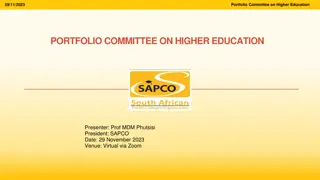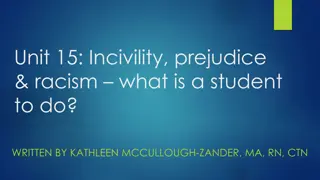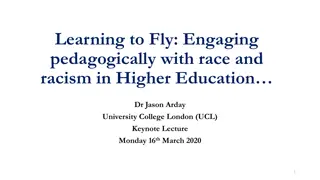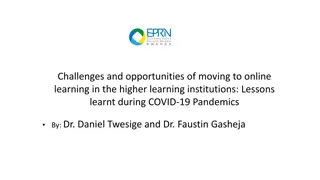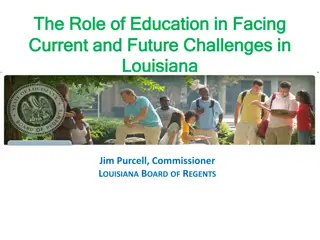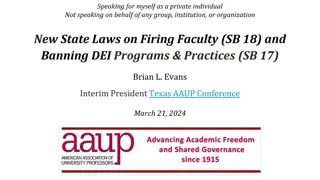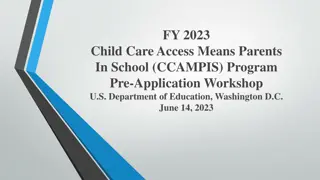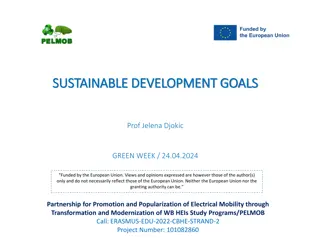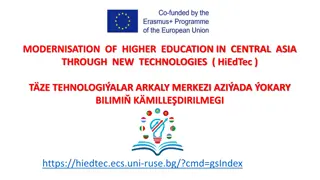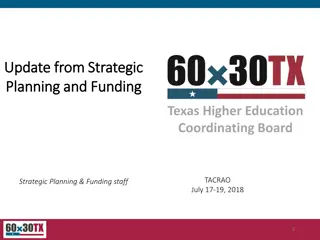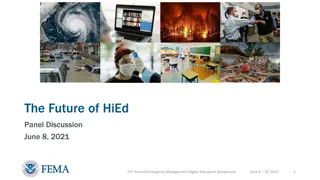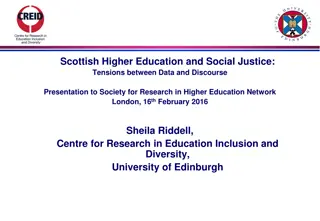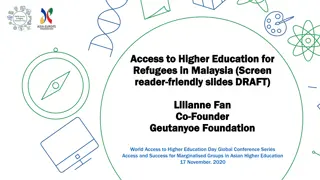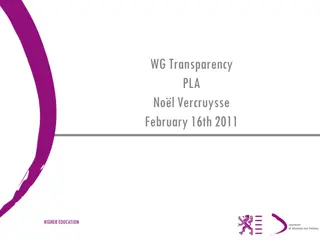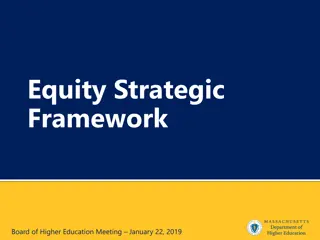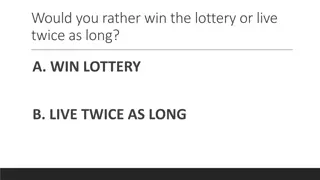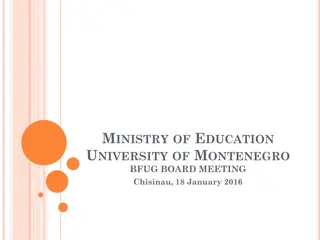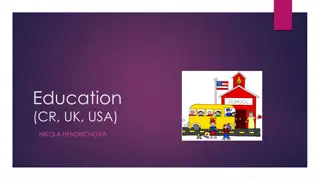Exploring Critical Perspectives on Inclusivity in Higher Education
Dr. Sean Walton from the University of Salford discusses the challenges of inclusivity in higher education, focusing on the attainment gap, ineffective diversity interventions, and theoretical perspectives on tackling inequalities. The presentation delves into historical phases of addressing race and ethnicity in higher education, issues of student achievement disparities, and potential solutions for enhancing inclusivity. The talk emphasizes the need for structural changes to address systemic inequities in academia.
Download Presentation

Please find below an Image/Link to download the presentation.
The content on the website is provided AS IS for your information and personal use only. It may not be sold, licensed, or shared on other websites without obtaining consent from the author. Download presentation by click this link. If you encounter any issues during the download, it is possible that the publisher has removed the file from their server.
E N D
Presentation Transcript
Some critical perspectives on inclusivity Dr Sean Walton (University of Salford) UHI Webinar 27thApril 2017
Introduction Work in one of the UK s most diverse higher education institutions. Persistent problem of the attainment gap . Ineffective/inefficient diversity interventions. Political climate. Competing/complementary theoretical perspectives that explain/tackle inequalities.
Application of theory General trends in the sector Our own institutions Student deficit model Interventions that work
Background Race, Ethnicity and HE Phase 1 Pre 1990 state of ignorance colour blind cultural deficit. Phase 2 1990 s Widening participation disproportionate numbers of BME students HE, but largely in New Universities. Emphasis on removing barriers to entry. Phase 3 2000 to present Gradual uncovering and recognition of a problem evidence base gradually begins to build (Connors, et al (2003) and (2004); Law et al (2004); Tolley and Rundle, 2006; Broecke and Nicholls, 2007; HEA/ECU (2008), Fielding et al (2008); ECU, 2010; NUS, 2011, Singh, 2011, HEA/ECU, 2011) Source: Cousin and Singh 2012
Defining the issues Relative to White students, those from every non-White ethnic group are less likely to obtain good degrees and less likely to obtain first class degrees The odds of an Asian student being awarded a good degree were half of those of a White student being awarded a good degree, whereas the odds of a Black student being awarded a good degree were a third of those of a White student being awarded a good degree (Richardson, 2007: 10). Focussing on categories and student achievement/performance may actually take our attention away from institutional structures and pedagogical practices . Reduces the historical struggle of justice and equality (political and pedagogical) to an endless wild goose chase for the absolute truth . We can get lost in the numbers game.
Raise the tariff and solve the problem Regulation modification Impact for students and staff In my own image Minorities or minoritised?
National context Rising numbers and % of BME students in higher education with 18% at present. BME students disproportionately from lower socio- economic groups. Concentration of BME students in small number of HEI s in particular post 92 universities.
Academic performance Young BME students take longer to complete their studies. Proportion of students getting 1st or 2.1 differs markedly between white and BME students and within the category of BME. The attainment gap increased from 17.2% in 2003/04 to a peak of 18.8% in 2005/06 and is now around that point (it fluctuates slightly from year to year). The ethnicity attainment gap ranges from 9.3% for qualifiers aged 21 and under to 29.8% for those aged 36 and over BME students attend less prestigious HEI s ; are more likely to drop out ; are less likely to get best results.
BME student perspective Problems with the curriculum, academic environment, teaching quality, assessment, and academic support. Racial and cultural bias among lecturers. Institutional and personal racism. Mistrust of the integrity institutions to deal with complaints fairly. Greater financial burdens e.g. high rate of fees a source of frustration. Support of the students unions. Language, communication barriers and difficulties. Feelings of isolation and alienation (NUS and other reports).
The Language of Diversity Diversity is a strong and emotive term that operates as an unquestionable proposition it is always already known as good/desirable within western liberal discourse. This goodness references democratising and equality concerns as well as being constituted as a modern term. Hence, to oppose it would be to align oneself with elitism , undemocraticness , and the past In this way [diversity] might be understood as a moral discourse and the power of moral discourses lies in their capacity to render alternative accounts unsayable (Archer 2007, p 648).
The language of diversity cont. Contemporary calls to diversify the curriculum appear unimpeachable, as evidence of an individual or institutional sensitivity to the dangers of racism and ethnocentrism. The moral and cognitive rationales behind such calls seems clear. If we broaden the curriculum to include a range of different intellectual traditions, different ways of knowing, and different racial perspectives, we will create a more inclusive higher education (Brookfield 2007, p 557).
Marcuses first form of repressive tolerance. Marcuse (1965) identifies the first form of repressive tolerance as the tolerance of intolerable ideologies and practices. This is a form of moral isolationism (Midgely 1981) or extreme epistemological relativism whereby all and any viewpoint is given equal consideration.
The first form of repressive tolerance in action Brookfield (2007) gives the following example of this first form of repressive tolerance in action: The call for creationism to be given equal weight in the curriculum alongside the theory of evolution with the implication that both have comparable scientific credibility. Teaching that climate change is a contested theory. Teaching that the idea of the bell curve as applied in the study of intelligence demonstrates that Europeans are intellectually superior to other people.
form of repressive tolerance. In all three cases, the logic of diversity requires that we frame classroom discussions of these issues in terms that give equal and serious consideration to both, or multiple, sides of an argument. Marcuse s point is that in giving equal consideration to views that reinforce the interests of White supremacy, global capitalism and religious fundamentalism, teachers end up undercutting their own intention of developing students powers of critical thinking (Brookfield 2007, p 559).
The second form of repressive tolerance. The second way that repressive tolerance manifests is by marginalising the views of repressed groups while, at the same time, presenting a fa ade of working in the emancipatory interests of such groups. There are parallels here with the Critical Race Theory idea of contradiction-closing cases .
Effects of the second form of repressive tolerance When a curriculum is widened to include dissenting and radical perspectives that are considered alongside the mainstream perspective, the minority perspectives are always overshadowed by the mainstream one. This happens even if the radical perspectives are scrupulously accorded equal time and space. As long as the dominant Whitestream perspective is included as one of several possible options for study, its presence inevitably overshadows the minority ones, which will always be perceived as alternatives, as others never as the natural centre to which students should turn (Brookfield 2007, p 559).
Marcuse on the second form of repressive tolerance the people exposed to this impartiality are no tabula rasae, they are indoctrinated by the conditions under which they live and think and which they do not transcend. To enable them to become autonomous, to find by themselves what is true and what is false for man in the existing society, they would have to be freed from the prevailing indoctrination (which is no longer recognised as indoctrination) (Marcuse 1965, p 98-99).
The one-dimensional university Bureaucratic and compliance culture in HE. Now college culture, once a haven for critical theory, mirrors that of commercial realms with an unsettling precision. The rhetoric and mentality of corporations are actualised in universities claims to marketplace excellence , a consumerist, anything goes curriculum, and increasingly desperate popular reliance on the college degree as security against obsolescence in the globalized economy (Cunningham 2013, p 544).
Critical Pedagogy in crisis Cunnigham argues that even the teaching of critical theory itself has become packaged and commodified and an (ironic) example of one- dimensionality. Disagreement amongst critical theorist: Critical Race Theory; Race Critical Theory; Marxist Critical Theory McArthur (2010) has called for an end to this disagreement amongst friends to focus on the real issues.
Critical Race Theory (CRT) Origins in the Critical Legal Studies (CLS) movement in the USA. A product of the perceived narrow focus of CLS on issues relating to class and economic inequalities. CRT scholars seek to create a theoretical base from which to understand the way that the law (and other institutions) operate to construct and maintain racial inequalities. Focuses on the lived experiences of the people of colour (to use a North American expression).
Kimberly Crenshaw on CRT In short, we intended to evoke a particular atmosphere in which progressive scholars of colour struggled to piece together an intellectual identity and a political practice that would take the form both of a left intervention into race discourse and a race intervention into left discourse. (Crenshaw et al. 1995, xix)
Critical Race Theory (CRT): Some assumptions. Racism is deeply embedded in Western Societies. It is the normal, everyday experience of people of colour. Racist assumptions, attitudes, and behaviour persist through deep seated and ingrained beliefs, practices and institutions. It is not something that will disappear over time, but is a fundamental characteristic of social reality. Interest convergence. There are few incentives to eliminate racism because it advances the interests of both White elites (materially). Race is a social construct. Race does not correspond to any hard and fast biological categories. Races are categories invented by society and are constructed, reconstructed, and made obsolete, as circumstance requires. Race is only real insofar as there are complex material structures and institutions that perpetuate it. Voice of colour. Because of their direct experience of oppression, people from non-White minorities may be able to provide insights into issues of race and racism of which Whites are unlikely to be aware.
Uses of CRT Analysis of UK Education System from CRT perspective. Analysis of political trends to portray the working class as white but not quite (Gillborn, 2010). Analysis of media portrayals of the white working class a victims of ethnic diversity. Research and analysis of media meta-narratives to portray diversity interventions as a waste of tax- payers money.
Idealist CRT An idealist school [of CRT] holds that race and discrimination are largely functions of attitude and social formation. For these thinkers, race is a social construction created out of words, symbols, stereotypes, and categories. As such, we may purge discrimination by ridding ourselves of the texts, narratives, ideas, and meanings that give rise to it and that convey the message that people of other racial groups are unworthy, lazy, and dangerous. These writers analyse hate speech, media images, census categories, and such issues as intersectionality and essentialism. (Delgado 2003, 123)
Materialist CRT Black people are the magical faces at the bottom of society s well. Even the poorest whites, those who must live their lives only a few levels above, gain their self-esteem by gazing down on us. Surely, they must know that their deliverance depends on letting down their ropes. Only by working together is escape possible. Over time, many reach out, but most simply watch, mesmerized into maintaining their unspoken commitment to keeping us where we are, at whatever cost to them or to us. (Derrick Bell, Faces a the Bottom of the Well, Epigraph)
Materialist CRT again Some believe that racism is dead, or that discrimination on the basis of class is much more serious. For Bell, the two forms of discrimination are intimately connected: The situation is not either-or. Much of racial discrimination rests on an economic base it is a means of securing class advantage. It is also a means by which elite Whites secure the cooperation of down-and-out working class whites, who might otherwise join forces with struggling blacks against the corporate forces that oppress them both. (Delgado and Stefancic 2005, 369)
Gillborn on race and class The benefits for the White working class are more mixed but, on balance, remain clear; they may face a tougher time qualifying for benefits but they know that their interests will be secure against those of minoritised groups because the solidarity of the White middle classes ensures that the spectre of racial violence (both symbolic and real) will be mobilised if, for example, their educational or employment prospects dip below those of key (especially Black) minoritised groups. In addition, this group can always console themselves that they are part of the respectable class fraction rather than the degenerate section. (Gillborn, 2010b, 21-22)
Some possible implications for practice. Focus is on curriculum design from only an inclusive perspective. Discusses perspectives within education that focus on the experience of minoritised and repressed groups e.g. CRT, feminist, Marxist critical pedagogues. Create safe space for critical engagement with concepts of diversity, inclusion, and identity and questions our understanding of our own identity, that of our learners, and the conceptual frameworks we use to understand our relationships (Cousin 2011, Foucault 1979, Lyotard 1974).
Any comments or questions? ?
